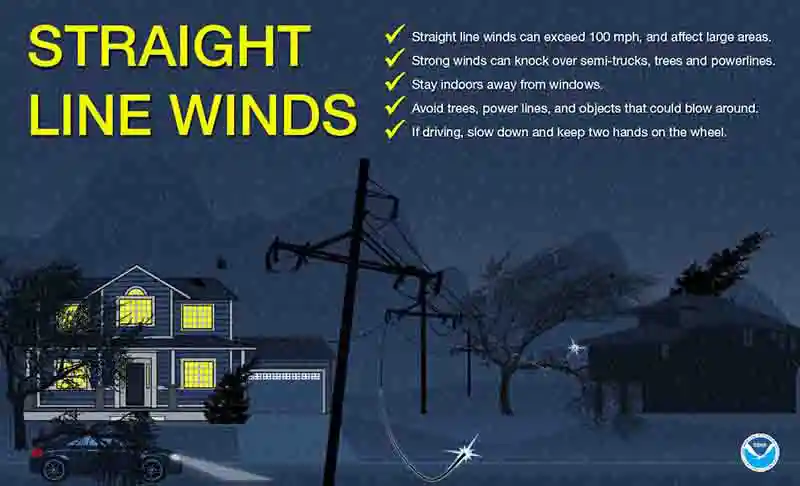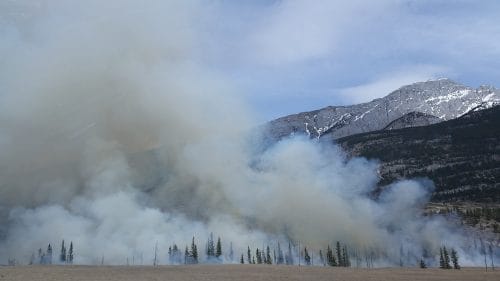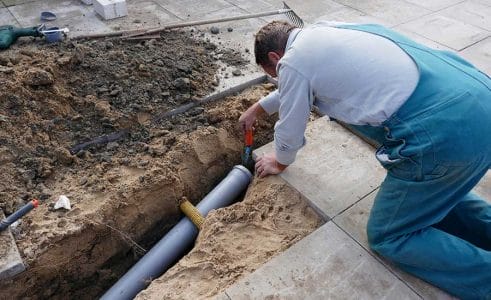What Are Straight-Line Winds?
When it comes to destructive weather systems, most people typically think of tornadoes or hurricanes, depending on where in the country they are located. However, there is another weather system capable of causing immense damage here in the United States — straight line winds.
Often confused with tornadoes, due to their ability to damage property, straight-line winds stem from non-rotating thunderstorms.
These powerful winds shoot downward at high speeds, spreading outwards when they reach the ground, sometimes reaching as much as 100 mph.
Although different than tornadoes, straight-line winds need to be taken seriously, especially by those who live in areas where they are prone to occur (straight-line winds are likely to form in the same locations where tornadoes are frequent).
Continue reading to learn everything you need to know about straight-line winds, including how they form, how they differ from tornadoes, and what you should do if they occur where you are located.
How are Straight-Line Winds Created?
Straight-line winds are caused by a difference in air temperature and density within a thunderstorm. When cool, dry air forms inside a thunderstorm, condensation and rain can continue to cool it until it eventually becomes heavier than the surrounding warmer air.
This weight difference, paired with the shift in temperature and density, results in a sudden downburst of air.
When the cool air reaches the surface of the Earth, it spreads outward, resulting in strong winds that can damage homes, vehicles, trees, and other structures.
Given the severity of the damage that can be caused by straight-line winds, if a straight-line wind warning is issued in your area, seek shelter as if it were a tornado.
Basements, closets, and other interior rooms away from windows are some of the best locations in which to take shelter during straight-line winds.
If you are unable to make it to any of these locations, getting under heavy furniture, such as a dining table, can help to protect you from broken glass or other falling objects.

What’s the Difference Between a Tornado and Straight-Line Winds?
As mentioned previously, straight-line winds are often confused with tornadoes. This is most likely due to the fact that they both feature powerful winds, can cause immense damage to properties, and tend to occur in similar locations throughout the country. However, despite their similarities, there are some key differences between straight-line winds and tornadoes.
Air Movement – To begin, tornadoes rotate, meaning air flows into them. Conversely, with straight-line winds, all of the wind comes from the immense downburst, pushing the air outward.
Debris Pattern – Another way to tell if an area has been hit by a tornado or straight-line winds is to look at the leftover debris. If it looks as if it has been thrown outward in a circular formation, it is probably a tornado. On the other hand, if the debris is linear, straight-line winds are more likely to be the culprit.
Can Straight-Line Winds Turn Into a Tornado?
Due to their similarities, many people wonder if straight-line winds can turn into a tornado. Because tornadoes are caused by rotating storms and straight-line winds come from thunderstorms that don’t rotate, straight-line winds do not typically turn into tornados. You are only likely to have one or the other depending on the weather system. Still, both are capable of endangering people and inflicting costly damage.
Cleaning Up After Storm Damage
If your property has been damaged by straight-line winds, contact the professionals here at BELFOR to help secure your property and prevent further damage from occurring. Our storm damage services include:
- Emergency Board-Up Service
- Perimeter Fencing
- Building Shrink Wrap
- Emergency Security Personnel
- Demolition and Reconstruction Services
You can also consult our mobile app to contact the BELFOR location nearest to you, request immediate assistance, and receive helpful tips on how to minimize damage to your property. Don’t put your property at further risk. Contact BELFOR for effective storm clean-up and recovery services.
.jpg)


